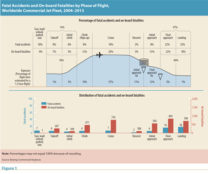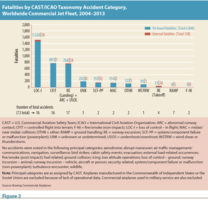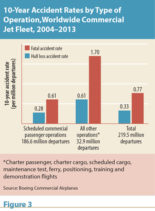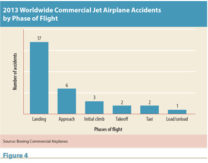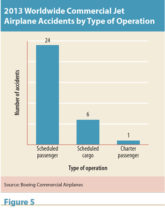Nearly half of all worldwide commercial jet airplane accidents during the 10-year period from 2004 through 2013 occurred during the final approach or landing phases of flight, according to statistics published in September by Boeing Commercial Airplanes. Of the 72 fatal accidents recorded during the period, 22 percent (16 accidents) occurred during the final approach phase and 25 percent (18) during landing. Those 34 final approach or landing accidents accounted for 1,554 on-board fatalities, or roughly 40 percent of the 3,848 on-board fatalities suffered during the decade (Figure 1).
Approximately 14 percent of the fatal accidents occurred during the takeoff (8 percent) and initial climb (6 percent) phases of flight; 10 percent occurred in cruise; 10 percent during taxi, towing, loading/unloading or while parked; 8 percent during climb (flaps up); 8 percent during initial approach and 3 percent during descent. Accidents in cruise accounted for 774 on-board fatalities, or approximately 20 percent of the total.
The data were analyzed in Boeing’s Statistical Summary of Commercial Jet Airplane Accidents, Worldwide Operations, 1959–2013. The aircraft manufacturer publishes similar sets of statistics on an annual basis. The statistics are for worldwide commercial jet airplanes that are heavier than 60,000 lb (27,216 kg) maximum gross weight, but exclude airplanes manufactured in the Commonwealth of Independent States or the former Soviet Union because of the lack of operational data. Commercial airplanes operated in military services also are excluded unless a military-owned commercial jet transport is used for civilian commercial service. Also, definitions related to the development of statistics in the summary are primarily based on corresponding International Civil Aviation Organization (ICAO), U.S. National Transportation Safety Board (NTSB) and Flight Safety Foundation terms.
ICAO and the U.S. Commercial Aviation Safety Team (CAST) have chartered the CAST/ICAO Common Taxonomy Safety Team (CICTT) to develop common taxonomies and definitions for aviation accident and incident reporting systems. The CICTT Aviation Occurrence Taxonomy is designed to permit the assignment of multiple categories as necessary to describe an accident or incident. In addition, CAST assigns each fatal accident to a single principal category.
CAST assigned 16 of the 72 fatal accidents that occurred from 2004 through 2013 to the loss of control–inflight (LOC-I) category; 16 to the controlled flight into terrain (CFIT) category and 17 to the runway excursion (landing) category, including abnormal runway contact and undershoot/overshoot accidents (Figure 2). The LOC-I accidents accounted for 1,526 on-board fatalities and 50 external fatalities. The CFIT accidents accounted for 803 on-board fatalities and one external fatality, and the runway excursion accidents accounted for 768 on-board fatalities and 28 external fatalities. A further four fatal runway excursion accidents on takeoff resulted in 13 on-board fatalities and 38 external fatalities during the period.
Over the 10-year period, the fatal accident rate for scheduled commercial passenger operations was 0.28 accidents per million departures, and the hull loss accident rate was 0.61, based on 186.6 million departures, according to the Boeing summary (Figure 3). The fatal accident rate for all other operations — including charter passenger, charter cargo, scheduled cargo, maintenance test, ferry, positioning, training and demonstration flights — was 0.61, and the hull loss accident rate was 1.70, based on 32.9 million departures. The total fatal accident rate, based on 219.5 million departures, was 0.33 and the hull loss accident rate was 0.77.
For 2013, Boeing counted 31 commercial jet airplane accidents, of which 17 (55 percent) occurred during the landing phase (Figure 4). Of the remaining 14 accidents, six occurred during approach, three during initial climb, two during takeoff, two during taxi, and one during load/unload operations. Four of the 31 accidents were fatal accidents, and an additional four involved serious injuries. A serious injury is defined as one sustained by a person in an accident and that, among other factors, requires hospitalization for more than 48 hours commencing within seven days from the date the injury was received; results in a bone fracture; causes severe hemorrhage, nerve, muscle or tendon damage; or involves injury to any internal organ. There were 62 on-board fatalities and no external fatalities in the four fatal accidents.
Twenty-four of 2013’s accidents occurred during scheduled passenger operations; six occurred during scheduled cargo operations and one during a charter passenger flight (Figure 5). Of the 31 accident airplanes, 25 suffered substantial damage, defined as “damage or failure that adversely affects the structural strength, performance, or flight characteristics of the airplane, and that would normally require major repair or replacement of the affected component.” Five of the 31 accident airplanes were categorized as destroyed and one was characterized as having no damage. In that case, a ground worker delivering final paperwork to the flight deck before takeoff fell from the entry door and was seriously injured. Thirteen of the accident airplanes were considered hull losses.
